|
|
|
Sort Order |
|
|
|
Items / Page
|
|
|
|
|
|
|
| Srl | Item |
| 1 |
ID:
120864


|
|
|
|
|
| Publication |
2013.
|
| Summary/Abstract |
The article examines the history of the relationship between the Iranian and the Russian monarchies during the nineteenth and early twentieth century. Drawing on a broad range of hitherto unexplored sources in Russian, the article analyzes Russian attitudes towards the Qajars, for whom the Romanov tsars were at the same time the most important ally and the biggest threat. The article focuses on the symbols and ceremonies by which the monarchs represented their relations, and by which they expressed symbolic competition, recognition and domination. The article thus opens a new perspective on Russia's influence on the Qajars and also raises questions about the comparative history of both monarchies.
|
|
|
|
|
|
|
|
|
|
|
|
|
|
|
|
| 2 |
ID:
120855


|
|
|
|
|
| Publication |
2013.
|
| Summary/Abstract |
The case of "homelessness in Iran" presents empirical evidence to demonstrate "how a small media organization affects and changes social discourse." The study investigates how the Iranian Students News Agency (ISNA) embodied the view of a news agency as having a role not only in the coverage of events, but also as an active agent of social change through discursive interventions. The process by which ISNA reconstructed homelessness and its empirical consequences is compatible with the five accepted stages labeled by Blumer. Homelessness represents the different ways in which ISNA has intervened in the social discourse in Iran: foregrounding a social issue, thematizing a discourse and problematizing social issues in order to open up a new kind of discourse.
|
|
|
|
|
|
|
|
|
|
|
|
|
|
|
|
| 3 |
ID:
120856
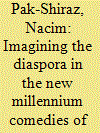

|
|
|
|
|
| Publication |
2013.
|
| Summary/Abstract |
This article examines the genre of comedy in Iranian cinema and explores the various influences on its development and growth. It demonstrates how the roots of recent comedies can be traced back to pre-Revolution commercial cinema (known as filmfarsi) as well as the traditional Iranian comic theatre of taqlid. In particular, it focuses on the depictions of the Iranian diaspora in these comedies. The Iranian diaspora has been imagined and represented frequently in modern Persian culture, often satirically and humorously. More recently, Iranian comedies have provided a new space to imagine, define, criticize and redeem the Iranian diaspora.
|
|
|
|
|
|
|
|
|
|
|
|
|
|
|
|
| 4 |
ID:
120858
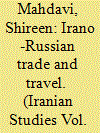

|
|
|
|
|
| Publication |
2013.
|
| Summary/Abstract |
Contacts between Russians and Persians have a long history going back to 1592 during the reign of the Safavid dynasty (1501-1736). However, the impact of Russia upon Persia was only felt as a result of military defeats in 1813 and 1828. In nineteenth century Persia there were many geographical obstacles which prevented foreigners including Russians from trading with Persia. This situation changed with the Treaty of Turkmanchai and its commercial protocol which gave Russian merchants special benefits and advantages. Consequently, by the 1860s Russian steamships started postal, passenger and cargo service from Baku to Persian Caspian ports and railheads advanced through the Caucasus to Tiflis. Persia traded with Russia on a much larger scale than with any other country. One of the Persian merchants who traded extensively with or through Russia to Europe was Haj Muhammad Hassan Amin al-Zarb (1834-98), the most prominent merchant of his time, and subsequently his son Haj Husayn Aqa Amin al-Zarb II. The article discusses Amin al-Zarb's trade and relations with Russia based upon unpublished material in the Amin al-Zarb archives in Tehran.
|
|
|
|
|
|
|
|
|
|
|
|
|
|
|
|
| 5 |
ID:
120860
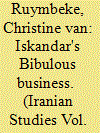

|
|
|
|
|
| Publication |
2013.
|
| Summary/Abstract |
The twelfth-century poet Nizami Ganjavi has produced his version of the adventures of Alexander as a unique composition mingling known Persian historiography and Qur'anic legends with unusual non-Islamic, especially Greek, elements in order to create his Iskandar-nama (containing two parts, the Sharaf-nama and the Iqbal-nama) as a synthesis of eastern and western cultures. A first point is the examination of the reasons behind the importance given to wine and drunkenness within the narrative. The poet has stressed this further by heading each chapter with a call to the saqi. The essay examines the appositeness of the invocations with the episodes in the narrative, it analyses examples of wine imagery (containing references to medicine, to the mirror and to religion) and questions the relation between authorial persona, narrator and characters, examining in particular the famous teetotaler claim in one of the introductory chapters of the first part of the Iskandar-nama.
|
|
|
|
|
|
|
|
|
|
|
|
|
|
|
|
| 6 |
ID:
120857
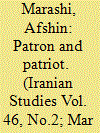

|
|
|
|
|
| Publication |
2013.
|
| Summary/Abstract |
This article examines the life and work of Dinshah Irani, a prominent Parsi scholar, lawyer and philanthropist who was a key intellectual intermediary between the Parsi community of Bombay and the intellectual community of Iranian nationalists during the 1920s and 1930s. The article details the role played by Irani in patronizing the publication of Zoroastrian-themed printed works in Bombay that were intended for export to the reading market in Iran. By focusing on the life and work of Dinshah Irani, the article details the important role the Parsi community of Bombay played in the revival of Iranian antiquity during the early twentieth century. The article also highlights the transnational cultural and intellectual history of Iranian nationalism during the Reza Shah period.
|
|
|
|
|
|
|
|
|
|
|
|
|
|
|
|
| 7 |
ID:
120861
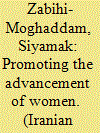

|
|
|
|
|
| Publication |
2013.
|
| Summary/Abstract |
In the early twentieth century, Iranian Baha'is were at the forefront of efforts to promote modern schooling for girls in Iran. Using previously untapped published primary sources and archival records, this article examines the history of the Baha'i schools for girls in the context of modern schooling of Iranian girls and assesses their contribution to female education in Iran. This contribution was significant and all the more remarkable considering the Iranian Baha'is' numbers and resources and the restrictions under which they operated. Most notably, in the spring of 1933, less than two years before the forced closure of Baha'i schools by the Pahlavi state, 4 percent of all females in Iran's accredited schools were enrolled in Baha'i schools. The Baha'i community's most prestigious school, Tarbiyat-i banat in Tehran, was by this time Iran's largest girls' school. Outside Tehran, in some localities, the only girls' schools were run by Baha'is, and in others a significant portion of all female pupils were enrolled in Baha'i schools.
|
|
|
|
|
|
|
|
|
|
|
|
|
|
|
|
| 8 |
ID:
120863


|
|
|
|
|
| Publication |
2013.
|
| Summary/Abstract |
This paper re-examines the causes of outbreak of Second Russo-Iranian War and the factors that played a role in its escalation into fully fledged war. The paper challenges the common perception that Qajar Iran played a major role in the outbreak of the war and proposes that the Qajar court took a defensive posture vis-à-vis aggressive Russian provocation originated in Tiflis and was merely reacting to it. The paper then examines policy differences between Tiflis and the court of St Petersburg as a contributing factor in the outbreak of the war. Finally, the paper examines two different and contradictory views of imperial Russia and its internal politics and military capabilities among Qajar Iran's decision makers during 1825-28. It is argued that the two perceptions eventually translated into two factions, each lobbying the shah for and against escalation of hostilities with Russia.
|
|
|
|
|
|
|
|
|
|
|
|
|
|
|
|
| 9 |
ID:
120862
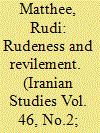

|
|
|
|
|
| Publication |
2013.
|
| Summary/Abstract |
This article examines the nature of Iranian-Russian diplomatic relations in the half century after the death of Shah ?Abbas I in 1629, probing the conflicts and mutual interests that prompted the two states to exchange envoys in this period of diminishing high-level contact. In particular, it seeks to reconstruct the Russian mission that visited the court of Shah ?Abbas II in 1664. By all accounts, this mission was treated in a most humiliating way in Isfahan, seemingly in accordance with what outsiders describe the contempt the Iranians felt for Russians. A careful examination of the available sources shows that the poor treatment of its members was due as much to concrete geopolitical concerns and anxieties as to the sense of civilizational superiority the Iranians may have felt vis-à-vis Russians.
|
|
|
|
|
|
|
|
|
|
|
|
|
|
|
|
| 10 |
ID:
120865


|
|
|
|
|
| Publication |
2013.
|
| Summary/Abstract |
This article reveals the story of Russia's attempts to colonize Astarabad and Mazanderan provinces of Iran in the early twentieth century. By backing and sponsoring Russian settlements there, the Russian government sought to eventually annex the territories in the northeast of Iran. Drawing on Russian and Iranian sources, the article follows the development of the settlements from their spontaneous beginning in 1907 to a state-supported colonization project by 1914. After the Russian government tried to accelerate colonization of the occupied Iranian territories during the First World War, this ambitious project came to an end with the Bolshevik coup of 1917.
|
|
|
|
|
|
|
|
|
|
|
|
|
|
|
|
| 11 |
ID:
120866
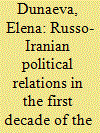

|
|
|
|
|
| Publication |
2013.
|
| Summary/Abstract |
In the 1990s, Russia and Iran successfully laid the foundations for interaction and expanded their spheres of cooperation. At the beginning of the twenty-first century, their relations developed unevenly. These fluctuations depended on the combination of global and regional factors, as well as on the internal circumstances in each country. Russia's participation in international sanctions has aroused discontent in Iran. Despite this, the political establishments of both countries continue to demonstrate an interest in developing bilateral relations and to reaffirm their shared geopolitical interests. This paper analyzes foreign policy documents and the latest research by Russian and Iranian scholars. It strives to shed light on the question: "To what extent and in what areas do the interests of Russia and Iran coincide, and what is the foundation for their potential future development?"
|
|
|
|
|
|
|
|
|
|
|
|
|
|
|
|
| 12 |
ID:
120859
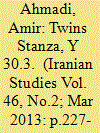

|
|
|
|
|
| Publication |
2013.
|
| Summary/Abstract |
The Gathic stanza Y 30.3 has always been at the center of various interpretations and controversies in Western scholarship on Zoroastrianism. Those who believe they have discovered in the Gathas a monotheistic religion armored with an ethical dualism have made this stanza one of the pillars of their thesis. The so-called Twins stanza shows, according to this view, that the good and evil primordial spirits exist as a result of their choice between Good and Evil, which preserves not only the absolute goodness of the supreme god but also his uniqueness. More recently Kellens and others following him have given a completely different reading of the stanza. According to their account, this stanza is a speculation on the hidden processes of ritual. What the poet expresses in Y 30.3 is not a dualism, ethical or otherwise, but a psychology of the process by which man makes his choice of ritual conduct. Aside from the question of coherence, one must ask whether these accounts are borne out by the text they claim as their basis. This article addresses these two questions.
|
|
|
|
|
|
|
|
|
|
|
|
|
|
|
|
|
|
|
|
|